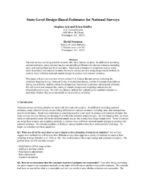
An official website of the United States government
Here’s how you know
Official websites use .gov
A .gov website belongs to an official government organization in the United States.
Secure .gov websites use HTTPS
A lock (
) or https:// means you’ve safely connected to the .gov website. Share sensitive information only on official, secure websites.
-
//
- Census.gov /
- Census Working Papers /
- State-Level Design-Based Estimates for National Surveys
State-Level Design-Based Estimates for National Surveys
State-Level Design-Based Estimates for National Surveys
National surveys are being asked to do more with their national samples. In addition to providing national estimates, many national surveys are providing different sub-national estimates including state- and metropolitan area-level estimates. Small-area estimation is sometimes used as a last resort to produce sub-national estimates but many surveys are also using design-based methods in creative ways with their national sample designs to produce sub-national estimates.
This paper gives an overview of how several U.S. Census Bureau surveys including the American Housing Survey, National Crime Victimization Survey, and the Consumer Expenditures Survey are applying innovative methods within the design-base framework to produce state-level estimates using a national surveys. The paper will review and compare the variety of sample designs and weighting methods for the aforementioned surveys. Some of the methods are incorporated directly into the sampling strategy of the national estimates and other methods were applied outside of the national estimates, e.g., state weights are produced. This paper also discusses methods for evaluating the resultant estimates to determine whether they are a reasonable set of state-level estimates. GVFs and graphs of CVs were shown to be useful for examining a set of estimates and are useful for surveys with a general purpose surveys. In this case, Census applied the GVFs and graphs of CVs to state estimates, but they can also be applied to other comparisons of different aspects of a sample design.
Share
Some content on this site is available in several different electronic formats. Some of the files may require a plug-in or additional software to view.
 Yes
Yes
 No
NoComments or suggestions?


Top

